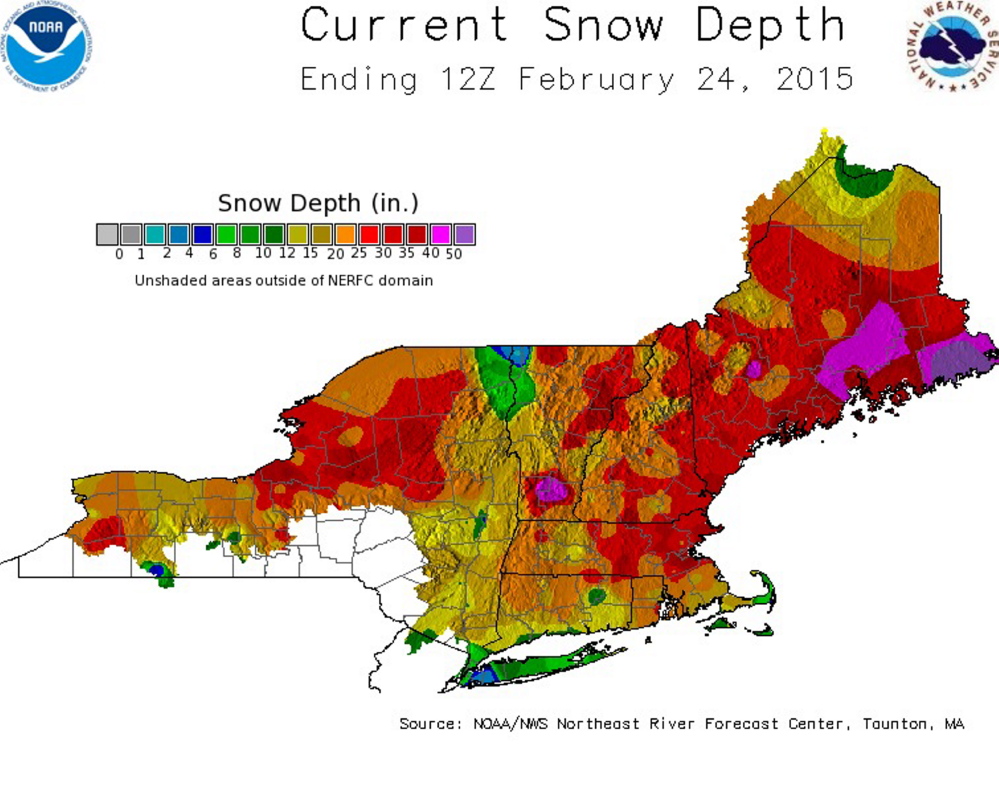When I got up on Monday morning, more snow had fallen. Then again on Wednesday, 4 or 5 more inches on the cleared part of the deck.
It was deja vu all over again. Monday’s new inch or two I brushed off the car first. Then I was flinging it with my Big Shovel out of the snow tunnel that leads from the cars (somewhere under there, gravel lies) up onto the deck.
I cleared this same tunnel again Wednesday. On Sunday I also moved a 6 or 8 inch ridge of chunks and slabs that was plowed up in front of the cars for the whateverth time in the past about five weeks.
Bonnie and I again knocked down the snow-volcano mounds surrounding the top of the driveway to clear the view of calamitous U.S. Route 202. Back-wrenching work I also did on Saturday. Re-dug the trench to the basement door. Re-dug a trench halfway along the back of the house so the next oil delivery will take place. Spent most of Friday afternoon on the garage roof. At least a ton of snow went over the edge.
Shovel, shovel, shovel. If this much snow (I start thinking while I’m shoveling) with food and warmth behind the next wall feels like this, what could the Donner party possibly have felt like?
A NOAA snowfall map shows that the middle swath of Waldo County, where Troy is located, had 40 to 50 inches of snow on the ground on Tuesday. The eastern and western edges of the county were in the 35 to 40 inch range. The 40 to 50 range extended into the middle of Penobscot County; 35 to 40 extended west toward Waterville and east into Hancock County. The lower half of Washington County was in the 40 to 50-plus range.
So on Monday, this one or two inches seemed simultaneously negligible and infuriating, depending on your frame of reference. Everybody from here to Wherever, Mass., Vt., N.Y. — name your favorite snowbound state — knows what I’m talking about.
Cold, too. An Accuweather chart showing high and low temperatures in Troy for February indicates the high made it into the 20s only seven times from Feb. 1 to 22, and 10 days reached 16 or less. The historical average highs for February days are right around 30 for most of the month.
But despite the relentless chill in the morning kitchen, the cold has been my ally. It’s kept the snow from turning into cement. Meaning that light and fluffy is fairly easy to knock off cars, skim from the deck and push off the garage roof.
Not convenient, mind you. My back hurt all day Sunday and took on a sort of aggrieved disposition again Monday. But if it wasn’t for an average daily temperature of something like (just eyeballing the chart, here) 8 degrees this month, heavy sticky snow could well have extended my discomforts into a range of medical requirements outstripping ibuprofen, ice packs and adolescent griping at the chiropractor’s office.
And really, it’s been colder than this. Our outside thermometers haven’t registered 20 below zero this year, which they have in plenty of winters past.
An op-ed piece in The New York Times last week, “Boston’s Winter from Hell,” points out startling imagery from a city socked with its record 8 feet of snow, some of it beautiful, some of it ridiculous. “But for those of us living here,” the writer says, “it’s not a pretty picture.”
No doubt. But then he says something that, from my vantage point, sounds sort of peculiar:
“We (in Boston) are being devastated by a slow-motion natural disaster of historic proportions. The disaster is eerily quiet. There are no floating bodies or vistas of destroyed homes. But there’s no denying that this is a catastrophe.” He notes the “crushed roofs, burst gutters, destroyed roads and sidewalks, closed schools and businesses, shut down highways, crippled public transit.” The unmoved snow has made driving complicated and dangerous. Some people can’t get to work and are losing wages, and some businesses are likewise losing money.
Boston is a mess, there’s no doubt about it. Eager to find out about the catastrophe, I read to the end.
But somehow, the only things that seemed to rise above the range of extremely inconvenient were the collapsed roofs, the lost wages and possibly some businesses’ lost revenue. It does not seem implausible that people might actually lose their homes due to lost pay. But has that actually happened? For right now, at least, that worst-case tribulation is hypothetical.
If lost income and inconvenient driving constitute catastrophe, then how do we describe, say, the January 2010 earthquake in Haiti or the December 2004 tsunami in Indonesia, in which hundreds of thousands of people were killed and most of the rest had, not trouble getting to work, but their homes destroyed and families wiped out?
I can sympathize with the Bostonians since my own driveway has turned into a crater of 8-foot snowbanks and on a couple of days the plow guy couldn’t come until morning and we could not get out. Overall, I’m glad I’m not in Boston. But catastrophic? I really don’t think anybody was joking around in a yeti suit after Haiti’s earthquake.
Although it seems unbelievable right now, this snow — even this unusually huge lot of it — is going to disappear. Like it always does, thankfully.
Suck it up, friends. It’s New England. It’s winter.
Dana Wilde lives in Troy. His writings on Maine’s natural world are collected in “The Other End of the Driveway,” available from online booksellers or by contacting the author at naturalist@dwildepress.net. Backyard Naturalist appears the second and fourth Thursdays each month.
Send questions/comments to the editors.




Comments are no longer available on this story